Role Queue Debate: Marvel Rivals and the Future of Hero Shooters
Updated On: August 23, 2025 by Aaron Connolly
The Role Queue Debate in Marvel Rivals
Marvel Rivals has kicked off some pretty heated arguments about role queue systems since it dropped. The developers have made it clear they won’t force players into specific roles, but players can’t seem to agree if that’s a good thing or not.
Some folks think this freedom helps keep the game fresh. Others say it just wrecks competitive play.
What Is Role Queue?
Role queue basically means you pick a role before you jump into a match. In games like Overwatch 2, you’ll see teams with two tanks, two supports, and two damage dealers.
That setup guarantees balanced team compositions. Every team gets someone covering the main jobs, so you don’t end up with everyone running damage heroes.
The main perks of role queue:
- Team balance every match
- Shorter queues for tank and support mains
- Strategies are a bit more predictable
But there are downsides:
- Damage players usually wait longer
- Teams lose flexibility in comps
- Switching roles mid-match gets tricky
Most hero shooters use some form of this to fix lopsided teams. People just love picking damage, and that often leaves teams with no tanks or healers.
How the Debate Began
Right after Marvel Rivals launched, the role queue debate exploded. Players started noticing the same old problems from other hero shooters.
Typical team issues popped up:
- Teams with five damage heroes and just one support
- Sometimes, no tanks at all
- Players digging their heels in and refusing to switch
Reddit threads filled up with complaints about lopsided matches. Calls for an Overwatch-style role queue came fast.
The community quickly split. Some want forced roles to guarantee balance. Others want the freedom to try weird team combos.
Why people want role queue:
- No more hopelessly imbalanced teams
- Matches feel more strategic
- Less arguing over who plays what
Why people don’t:
- It kills creative team strats
- Marvel’s Team-Up mechanics get restricted
- Players lose the chance to experiment
Current State of Role Queue Discussions
Marvel Rivals’ creative director, Guangyun Chen, keeps saying a hard no to role queue. In December 2024, he doubled down—no plans to add it.
Chen said role queue would hurt the Team-Up feature. That’s the mechanic where Marvel characters mix their powers for wild combos.
“We want to offer more line-up possibilities through our hero design and team-up mechanic,” Chen told Metro UK. The devs believe forced roles would just limit those cool combos.
Where the devs stand:
- No role queue in any mode
- They’re putting energy into hero balance instead
- Player freedom and experimentation come first
Players still seem split. Some have gotten used to the current system and are finding fun new team comps. Others keep pushing for role queue, at least in ranked.
Reddit’s full of compromise ideas. Some suggest role queue for competitive, but leave casual modes open. The devs, though, aren’t budging.
Arguments Supporting Role Queue
Fans of role queue say it fixes the basics: team balance and player experience. They focus on fair teams, better competitive integrity, and less frustration in messy matches.
Balancing Team Composition
Role queue makes sure every team gets the right mix. Without it, you’ll see five DPS and no support way too often.
The main issue: Tons of players just don’t want to play tank or support. Some research says about a third of folks won’t touch tank at all.
That means open queue gets messy fast. Players complain about “5 ADC and no healers every time” or weird lineups like “1-3-2” instead of the classic “2-2-2.”
Role queue fixes this by locking in numbers for each role. Teams always get two DPS, two supports, and two tanks.
Why that’s good:
- Teams always have healers
- Tanks can actually hold objectives
- Damage is spread out
- No more last-second panic role swaps
It works because it forces variety. If you queue support, you’re playing support, period.
Improving Competitive Play
Competitive play needs fair matchmaking and set team structures. Role queue brings that consistency to every match.
Pro esports teams use set roles for a reason. They need clear responsibilities and plans that fit their comp.
Role queue gives regular players a taste of that structure. Both teams know what to expect and can plan around it.
Matches just feel better when supports actually want to heal. Tank mains know their job, and DPS doesn’t get stuck tanking by accident.
Competitive play gets:
- More strategic depth
- Better team coordination
- Less randomness in team strength
- Matchmaking that’s actually skill-based
Games become about skill and teamwork, not just lucking into a good comp.
Reducing Player Frustration
Open queue puts a lot of social pressure on players. Role queue cuts out those awkward pre-match debates over who fills what role.
Millions of players hate being forced into support. Lots of gamers say they only flex to avoid awful comps.
Role queue lets you pick your favorite role before you even start. Support mains get to play what they love, and everyone else can avoid roles they dislike.
This drops toxicity a lot. Teams argue less when everyone agreed up front.
Players are happier because:
- They stick to roles they enjoy
- No guilt trips to fill unwanted spots
- Fewer arguments before the match
- The overall vibe is just better
Role queue respects what players want, while still keeping teams balanced.
Concerns About Introducing Role Queue

Not everyone’s convinced role queue is the answer. Some players think it could actually cause more problems than it solves.
The main worries? Less flexibility, longer wait times, and people trying to game the system.
Impact on Flexibility
Role queue can make matches feel stiff and predictable. When players get locked into tank, damage, or support, teams can’t really adapt on the fly.
That’s a problem if the match calls for a different comp. Open queue lets teams pivot if something isn’t working or if the enemy does something unexpected.
Some folks argue that locking roles stops the meta from evolving naturally. Players should get to experiment and find their own strategies instead of being boxed in.
Marvel Rivals’ devs already said no to role queue partly for this reason. They want teams to try wild comps, even if it’s not the norm.
Longer Queue Times
One big headache with role queue? Waiting around for a match. Certain roles—usually tank—just aren’t as popular.
Tank mains are rare, so DPS and support players wait longer. When a bunch of people queue at once, the wait can get ridiculous.
Overwatch has this problem in spades. Damage players sometimes wait 10-15 minutes, which honestly, most casual players just won’t tolerate.
It gets even worse with smaller player bases. Regional servers or niche modes might struggle to fill up role slots quickly.
Potential for Role Lock Abuse
Some players abuse role queue by picking roles they don’t actually want to play. That’s a nightmare for teammates who expect everyone to pull their weight.
A few queue for faster roles (like tank or support) but then play selfishly or ignore the team. That just defeats the whole point.
It also happens when players get stuck in a role they hate. They might throw, quit, or just phone it in because they feel trapped.
When players game the system, everyone loses. You end up with rigid roles, but still unreliable teammates.
Marvel Rivals Developers’ Perspective
NetEase Games hasn’t budged on their stance against role queue in Marvel Rivals, even though lots of players keep asking. Their whole philosophy centers on player freedom and letting people experiment.
Freedom of Experimentation
The devs see role queue as a straight-up limitation. They think forcing certain comps would just make the game boring and predictable.
No role queue means players can run wild with their teams. Six vanguards? Sure, it’s chaos, but you might stumble onto a strategy nobody’s seen before.
They argue this sort of freedom sparks creativity. Sometimes, the best combos come from trying something totally off-meta.
Marvel Rivals really pushes team-up abilities. Those shine brightest when players can pick any hero that fits their plan.
Yeah, some matches might lack healers or tanks. NetEase thinks that just forces players to adapt and maybe swap roles mid-game.
Vision from Guangyun “Guangguang” Chen
Game director Guangyun Chen keeps standing by the no-role-queue call in interviews. He says their approach is nothing like the usual hero shooter.
Chen believes role queue clashes with Marvel Rivals’ identity. He wants players to “assemble their teams” like real Marvel heroes would.
The director stresses that teams should find balance through communication, not automated systems.
Chen said: “We believe no role queue will lead to a richer gaming experience for everyone.” That’s what drives their matchmaking.
The devs see unbalanced matches as a chance to learn. Players have to adjust their picks and tactics on the fly.
Inspiration from Marvel Lore
NetEase pulls a lot from Marvel comics and movies for their team philosophy. The Avengers never stick to strict roles when they face threats.
This “Marvel-style” teamwork means heroes adapt as needed. Maybe Iron Man tanks for a bit while Spider-Man helps out in support.
The devs want Marvel Rivals to feel like that—flexible, not locked down.
Team-up skills are built to mirror Marvel partnerships. They just work better when players aren’t forced into certain roles.
NetEase thinks this approach nails the Marvel vibe. Every match becomes its own superhero story, not just another formulaic competition.
Comparisons to Overwatch and Other Hero Shooters
Overwatch‘s role queue system kicked off a debate that still shapes every new hero shooter. Marvel Rivals and others now have to pick between structured teams or letting players run free.
Overwatch’s Role Queue Impact
Role queue really shook up Overwatch when it dropped in 2019. Now, you have to pick your role before you even get into a match.
Back in the day, teams would often stack five damage heroes and maybe one support. That led to some lopsided, frustrating games. Sure, queues were quick, but the matches? Not so much.
Once role queue arrived, things felt more balanced. Every Overwatch 2 team now gets 2 damage, 2 support, and 1 tank (source). But queue times shot up, especially if you want to play damage.
Some folks loved the change. Others? Not so much—they felt the game lost its creative spark. There’s still debate about whether this was the moment Overwatch started bleeding players.
Competitive players seem to appreciate the structure. Meanwhile, casual fans sometimes miss the wild chaos of open queue.
Differences in Team Design Philosophy
Marvel Rivals takes a pretty different route compared to Overwatch. The devs put player freedom above strict balance.
Marvel Rivals philosophy:
- Pick whoever you want
- Mix up the team comps for variety
- No role restrictions means more strategy options
Overwatch philosophy:
- Balanced teams make better matches
- Structure stops one-sided stomps
- Each role gets a clear job
Marvel Rivals devs admit their tanks and supports aren’t all that interesting yet. They’re still working on making those roles fun before they even think about adding role queue.
This leads to a classic chicken-and-egg problem. Players skip boring roles, so matches get weirdly unbalanced. But just forcing a role queue won’t fix bland hero design, right?
Influence on the Hero Shooter Genre
These days, every new hero shooter faces the role queue question. Do you go for structure or let players run wild?
Games with role restrictions:
- Overwatch 2 (strict role queue)
- Some competitive modes in other games
Games with open queue:
- Marvel Rivals
- Paladins
- Most new hero shooters, at least at launch
New shooters run into a dilemma. As casuals drift off and the playerbase shrinks, role queue might become necessary. Early on, most people just want to play damage anyway.
Developers are watching Marvel Rivals closely. If it does well without role queue, others might copy that. But if matches get too messy, expect more games to copy Overwatch’s system.
A lot of devs now plan for role queue from the start. They try to make every role appealing instead of fixing balance after launch.
Community Reactions on Social Platforms

Players on Reddit, streaming sites, and in gaming circles have a lot to say about role queue systems. Some folks argue endlessly, while others break down the pros and cons in detail.
Reddit Discussions
If you check out r/Overwatch or r/MarvelRivals, you’ll find some of the most in-depth role queue debates out there. People compare queue times, match quality, and team coordination all the time.
Popular topics:
- Queue time differences between role queue and open queue
- Screenshots showing wild, unbalanced teams from before role queue
- Polls on which system people actually like
Marvel Rivals’ subreddit is especially interested in whether the game should add a role queue. Lots of posts break down team comp issues in current matches.
Common Reddit takes:
- “Role queue saved competitive integrity”
- “Flex players got screwed over”
- “Queue times just aren’t worth it”
Players often share stories of matches that totally fell apart because of weird team comps. These examples help explain why some support role queue.
Streamer and Influencer Opinions
Streamers and content creators have a big influence on community opinions. Their live takes and reaction videos reach thousands every day.
On streaming platforms, people talk about:
- Live reactions to queue times
- Viewer polls on role queue preferences
- Comparing gameplay between queue systems
Streamers sometimes swap between role queue and open queue mid-stream. It’s a pretty effective way to show viewers the real differences.
Influencer content covers:
- Explainers about why role queue might be good
- Rants about long DPS queues
- Reactions to new role queue news
Because viewers feel close to their favorite streamers, influential creators can sway opinion a lot. If a big streamer trashes role queue, you’ll see more negative posts in their community.
Common Player Complaints
Players across different games and platforms complain about similar things. These issues keep coming up no matter how the system is set up.
Top complaints:
| Issue | Player Impact | Frequency |
|---|---|---|
| Long queue times | Especially for DPS players | Very High |
| Reduced flexibility | Can’t switch roles mid-match | High |
| Skill gaps | Role-specific SR creates imbalances | Medium |
| Queue dodging | Players leave when they don’t get their role | Medium |
Specific frustrations:
- “I used to flex, now I’m stuck”
- “20-minute DPS queues are a joke”
- “My tank rank is way lower than my DPS”
Players often feel boxed in by role queue. Losing the ability to flex really annoys people who used to fill whatever the team needed.
Platform-specific issues:
- Console players say queues are even longer
- Lower-skill players feel forced into roles they hate
- Competitive players worry about less strategy
Role Queue Effects on Competitive Play
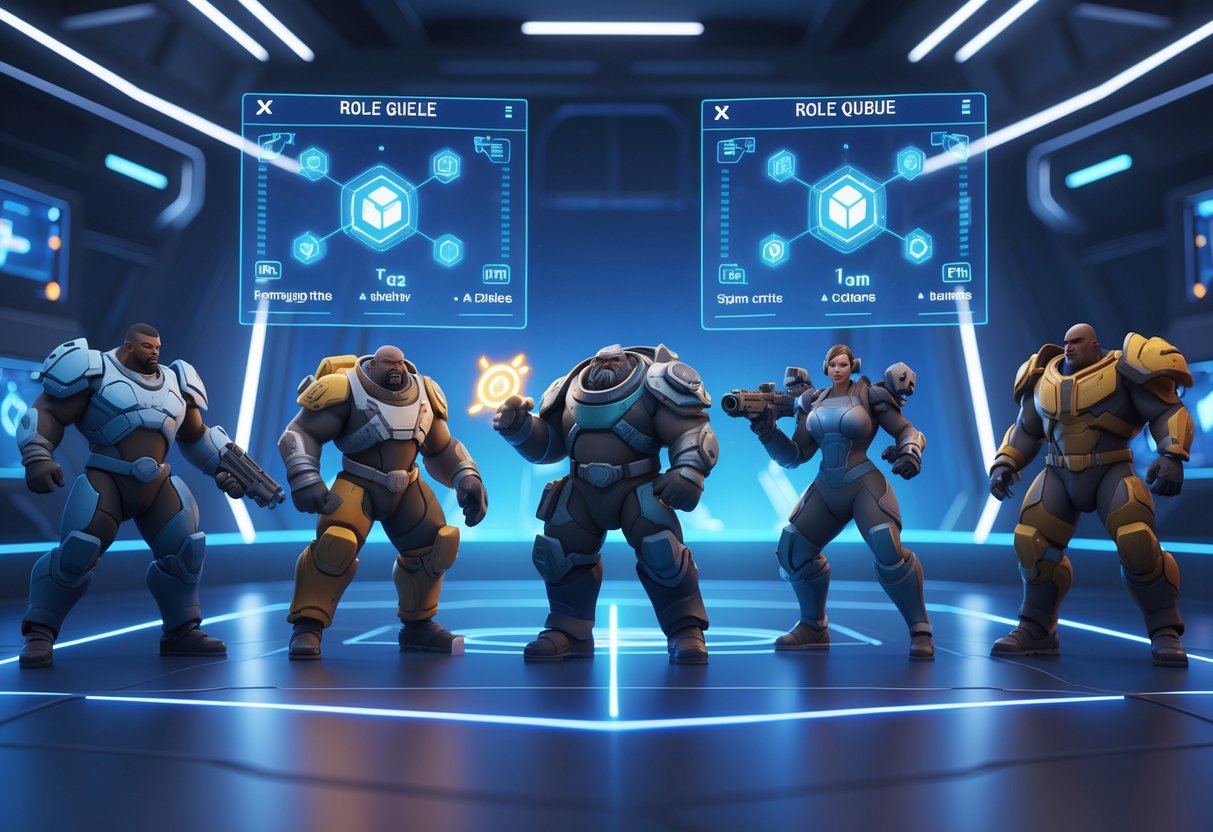
Role queue has totally changed how teams form and how players climb the ranked ladder. Now, instead of chaos, you get structured matches where everyone knows what they’re supposed to do.
Structured Team Building
Role queue gives you predictable team comps. Every game, you get two damage, two supports, and two tanks.
This setup stops the “5 ADC and no healers every time” problem that open queue had. Players pick a role and stick with it for the whole match.
Tanks have always been in short supply. Since “a third of the player base does NOT play tank”, role queue forces teams to fill that spot.
Structured teams mean:
- Consistent balance at all skill levels
- Players can focus on one role
- Fewer fights over who plays what
- Matches feel more strategic, less random
But there’s a downside—queue times for damage players get much longer. Tanks and supports get in quick, but DPS mains can be waiting 5-10 minutes or more.
Ranked Ladder Implications
Role queue changes how you climb ranks. Instead of one big rank, you get a separate rating for each role.
This makes matchmaking fairer. You might be a great support but a terrible tank, and now that actually matters.
Ranking changes:
- You get skill ratings for damage, tank, and support
- No more carrying by swapping to an easier role mid-game
- Skill assessment is more accurate
- Smurfing is harder since each role needs to be leveled up
Now, players can’t “soft throw by playing a role/hero that was 500-1000 SR under the current lobby”. You play at your actual level for each role.
Queue times are still a sore spot. Damage players wait longer, while tanks and supports breeze in. It’s not exactly a fair experience for everyone.
Professional Esports Perspective
Pro teams get a lot out of role queue in ranked. It gives them practice that matches tournament play.
Pro players can focus on their main roles instead of filling gaps. Support mains don’t have to mess around on tank just to get a game.
For pros, role queue offers:
- Practice that matches tournament rules
- Role specialists stay sharp
- Better prep for official matches
- Less time wasted on junk games
Still, some pros say open queue teaches you to adapt. You learn how to handle weird team comps and get a broader view of the game.
The structure helps up-and-coming players focus their skills. You can get really good at one thing instead of being mediocre at everything.
Most pro leagues already use structured team formats, so role queue in ranked lines up with what the pros need.
Role Queue in Casual Play
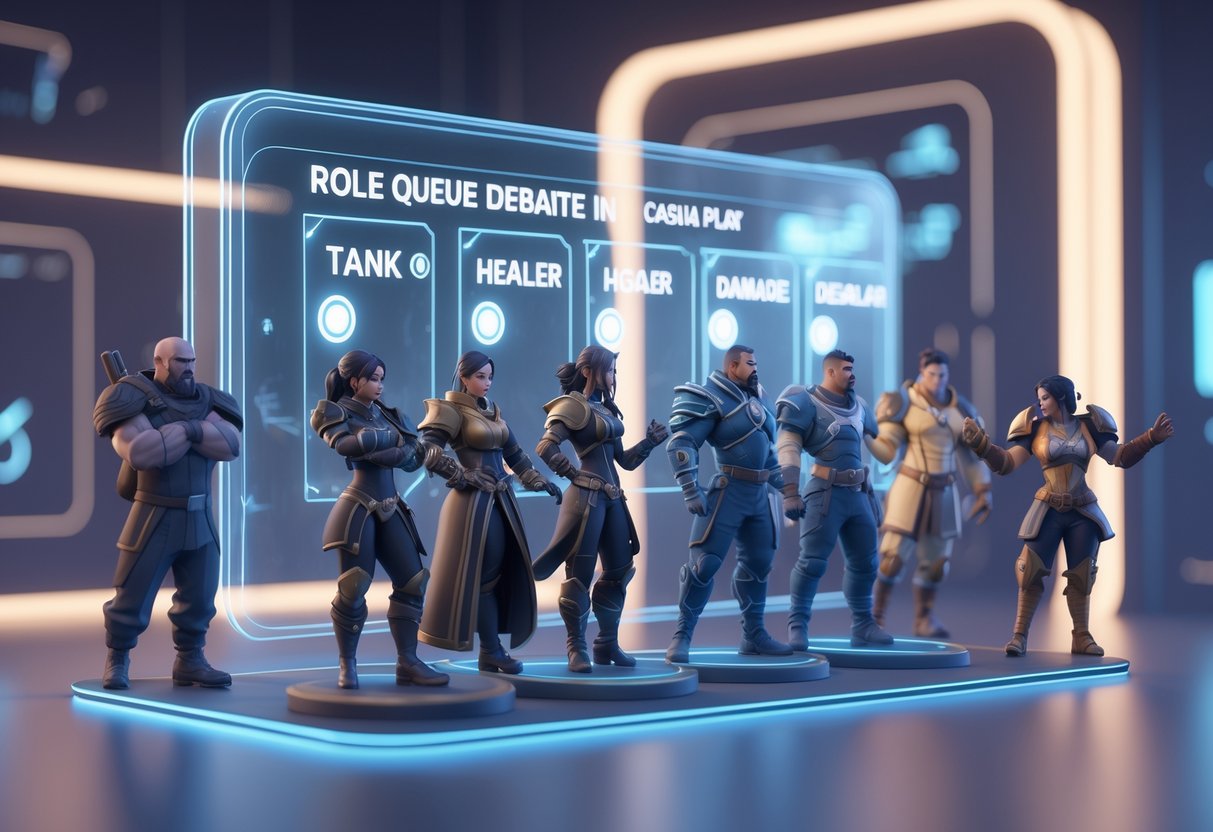
Casual play faces a tricky choice: stick with structured role queue or let everyone pick whatever in open queue. Most casual players just want to try new heroes and mess around without long waits or strict team setups.
Open Queue Versus Role Queue
Open queue lets you pick any hero during the match. That leads to some wild, sometimes hilarious team comps, but also plenty of frustration.
Open Queue Pros:
- Fast matches
- You can swap heroes mid-game
- More creative team options
- No role limits
Role Queue Pros:
- Teams are always balanced
- Tanks and supports get short queues
- You can play your favorite role
- Fewer arguments over picks
A lot of casual players prefer open queue—it just feels more chill. You can try out new heroes without being locked into a role.
Role queue in casual modes often means long waits for DPS. Some games report 10+ minute queues if you want to play damage.
Player Freedom and Choice
Freedom is a big deal for casual gamers. Role queue can take away that experimental vibe.
Without role restrictions, you learn a bunch of heroes just by playing. That builds up your game sense over time.
Why freedom matters:
- Switch roles for the team
- Try weird strategies
- Play with friends, no matter what they like
- Learn the game by doing
Role queue fans say it cuts down on toxic behavior and keeps matches fair. But honestly, a lot of casual players care more about having fun than perfect team balance.
Maybe the best move is to offer both. Let players pick role queue for structure, or open queue for a more relaxed experience.
Team Composition and Role Diversity
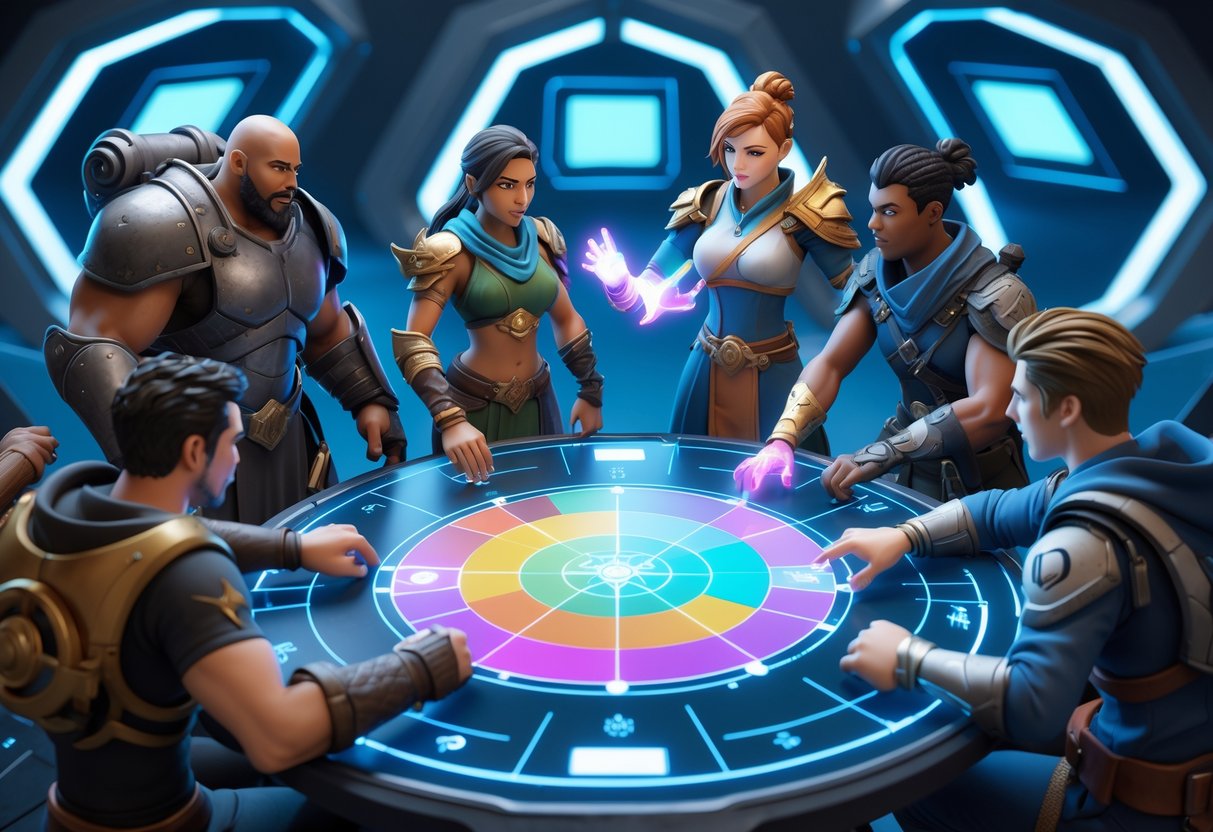
Competitive games usually need balanced teams with tanks, supports, and damage dealers. Without role queue, teams often run into trouble—too many people want the same job, or nobody wants to fill that one crucial spot.
Typical Team Line-Ups
A standard team usually covers five core roles. Tanks soak up damage and shield teammates. Supports heal and help with buffs or crowd control.
Duelists go for quick kills, dealing big damage but not taking much themselves. Vanguards start fights and make space for their team.
Strategists handle team movement and call shots. They often overlap with supports but focus more on the big picture.
Here’s how roles usually break down in a five-player team:
| Role | Primary Function | Team Count |
|---|---|---|
| Tank | Damage absorption | 1-2 |
| Support | Healing/utility | 1-2 |
| Duelist | Damage dealing | 2-3 |
| Strategist | Shot calling | 1 |
Common Role Distribution Issues
Without role queue, teams run into a bunch of problems. Players just pick what they like, ignoring what the team actually needs. That’s how you end up with four damage dealers and no tank.
Support shortage is a classic issue. Not many people want to play healers, so teams have a hard time finding someone to fill that role.
Role conflicts pop up when several players want the same spot. Arguments break out during character select. Sometimes, people refuse to swap even if it hurts the team.
Some players only know one role. When they get forced into something new, their performance drops. That leads to skill gaps opponents can abuse.
Strategies for Working Without a Role Queue
Teams need good communication in games without role selection. It helps to talk about roles before the match starts. Quick chat or voice comms make it easier to coordinate picks.
Flexibility training is valuable. If you learn a few different roles, your team won’t fall apart when someone else takes your main. Players who can fill gaps become super useful.
Playing with friends solves a lot of these problems. You can agree on roles ahead of time and avoid most arguments.
Some communities use role calling systems. Players call out what they want early, and it’s first-come, first-served. It’s not perfect, but it cuts down on fights.
Teams can also adapt to weird lineups. If you have lots of supports, focus on sustain and longer fights. If you’ve got all damage dealers, aim for fast picks before taking too much damage.
Impact on Player Experience and Game Balance
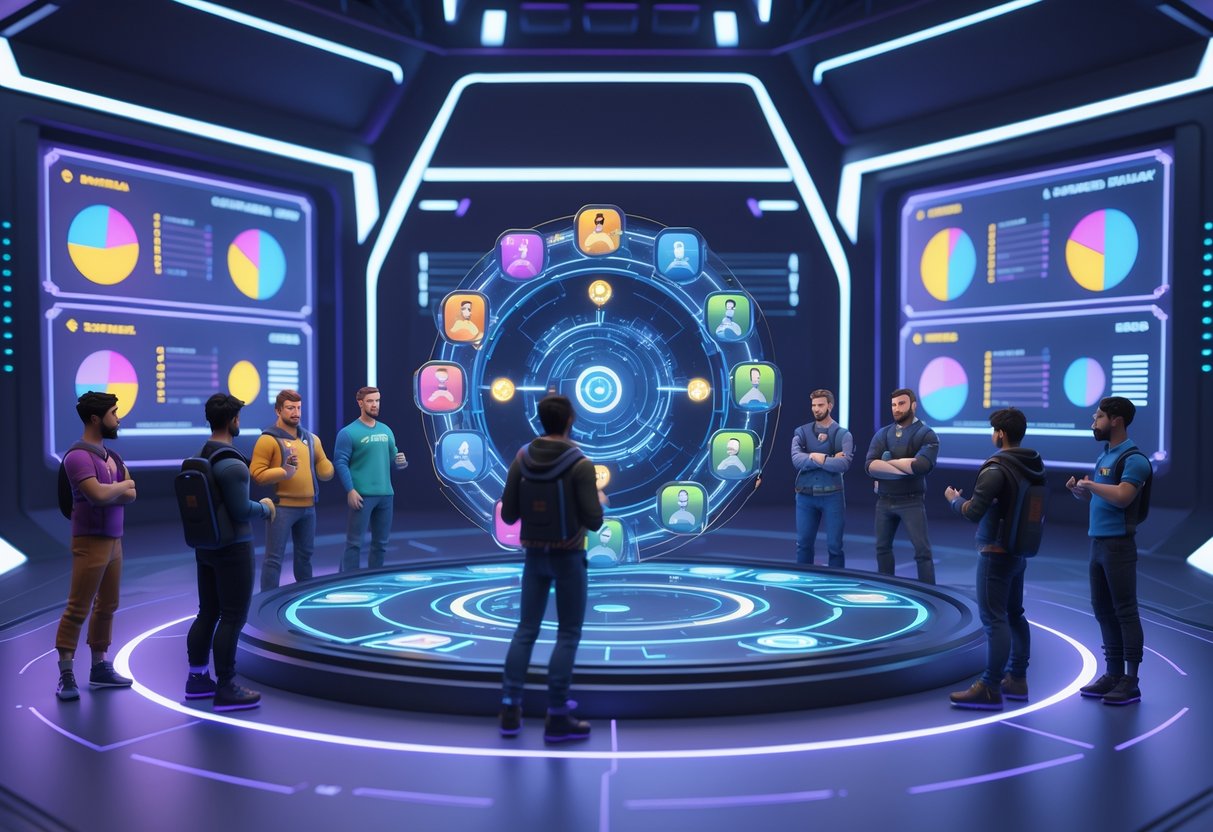
Role queue systems really change how people experience competitive games. They touch everything—from how new players get started to whether seasoned players stick around.
The tug-of-war between structured teams and letting folks play what they want? That creates some real headaches for both casual and hardcore gamers.
Learning Curve for New Players
New players get wildly different first impressions depending on whether a game uses role queue or not.
When there’s no role queue, beginners often end up in chaotic matches. Sometimes everyone just picks damage dealers, and nobody wants to play tank or support.
That chaos usually leads to frustrating games. Newcomers don’t get to learn the basics, and a lot of them quit after a few bad matches.
Role queue helps by making sure teams always have the right mix of roles. Players can actually learn how to play their chosen role, since the team will always have the other essentials covered.
But there’s a flip side. Role queue can trap people in one role, so they never really understand what it’s like to play the others. That narrow focus can stunt overall game sense.
Quick win: If you can, try both systems. Start with role queue to get the basics down, then switch to open queue to see how the other roles work.
The structure gives players a shot at building solid skills, instead of just scrambling to make sense of random teams every match.
Maintaining Excitement and Variety
Role queue tends to make matches feel a bit formulaic. Team setups start to look the same, and honestly, that can get a little stale.
Marvel Rivals’ developers push back against role queue for this exact reason. They want players to try wild team comps and cook up weird strategies.
Without role queue, you’ll sometimes see teams run three tanks or go all-in on damage. These off-the-wall ideas can turn games on their head and keep things interesting.
Still, letting everyone pick whatever can backfire. You’ll run into matches where nobody wants to play support, and suddenly, the whole thing’s a mess.
Warning: If nobody wants to fill the less glamorous roles, games can get lopsided fast.
Whether matches stay fun really depends on teammates being willing to talk and adjust their picks. Sometimes you get a team that works together, but not always.
Long-Term Community Satisfaction
Gamers have strong opinions about role queue. When Overwatch added it in 2019, it fixed some issues—but arguments about whether it’s actually better still pop up all the time.
Queue times have become a big sticking point. Damage players often sit in matchmaking limbo, while support mains jump right into games.
That creates a weird split. Some players get instant action, while others wait around and maybe lose interest in ranked play altogether.
Role queue changes how developers balance their games, too. With set team comps, devs can fine-tune balance updates, knowing exactly what roles will show up.
But that precision comes at a cost. It limits the kind of creative strategies that sometimes make games legendary. Some of the best moments happen when teams try something totally unexpected—something role queue might not allow.
Long-term success really hinges on whether devs can keep role variety alive and queue times manageable. The games that pull this off tend to keep their players happier for longer.
Potential Future Evolutions for Role Queue
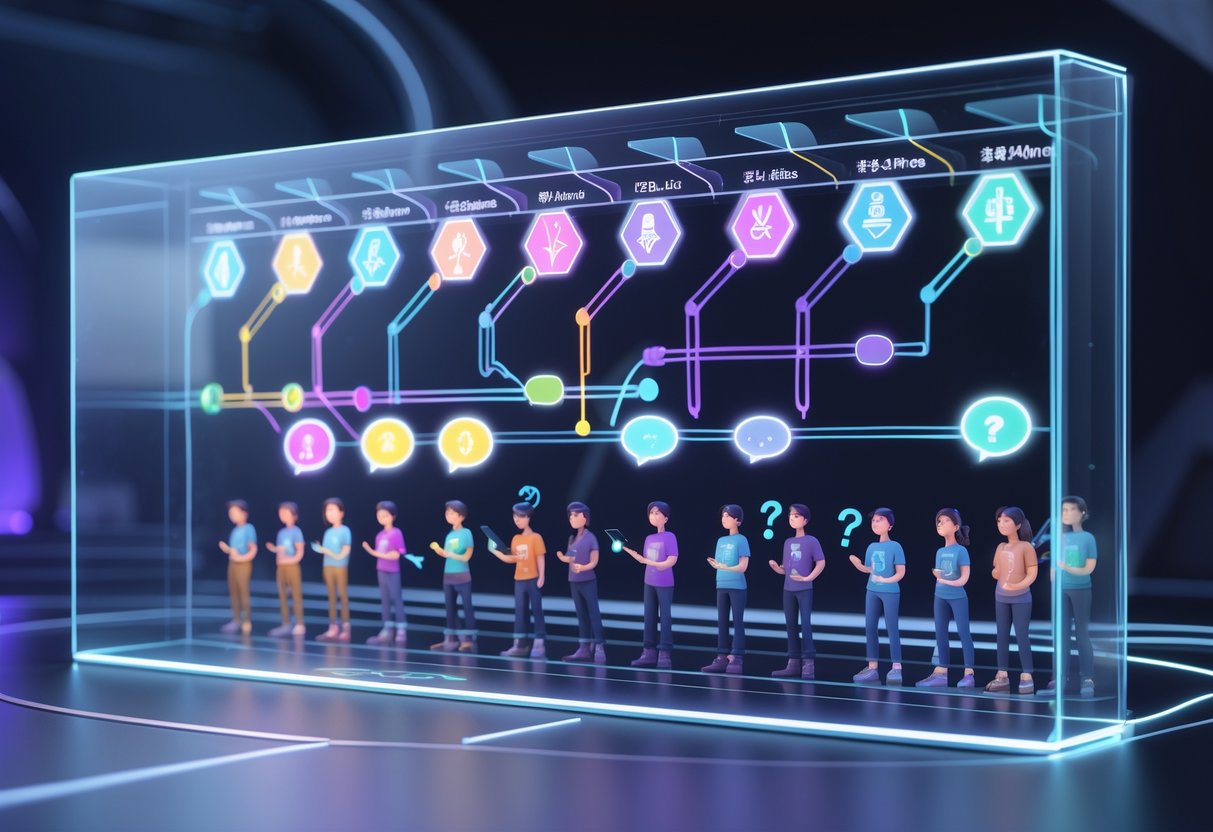
Game studios are looking into hybrid systems that mix structured roles with more freedom. Community feedback keeps pushing developers to rethink matchmaking.
Possible Hybrid Systems
Some studios are experimenting with mixed approaches. Marvel Rivals’ team, for example, has floated the idea of adding role queue just for competitive play, while keeping quick matches open.
This way, competitive folks get the balanced teams they want, and casual players can still mess around with any character.
Developers are also tinkering with smart queue systems that react to player habits. The idea is to suggest roles based on your recent games, or balance teams without forcing strict role locks.
There’s also talk about time-based role restrictions. Maybe you could swap roles mid-game after a certain amount of time, or when something specific happens.
Developer Statements on Future Changes
Marvel Rivals’ devs have made it clear—they don’t think role queue will help their game. They say forced roles kill tactical flexibility and stifle creativity.
Other studios are taking a different route. Overwatch 2 keeps tweaking its role queue, using player feedback and queue time data to make changes.
Devs worry about a few things:
- Splitting the player base across too many queue types
- Matchmaking getting more complicated
- Longer waits for popular roles
- Losing some of the strategic variety that makes games fun
Some teams are even trying out machine learning to predict team balance, hoping to avoid strict role rules altogether.
Community Suggestions and Polls
Players aren’t shy about sharing ideas to fix role queue’s problems. A lot want fill systems that let them pick more than one preferred role to speed up matchmaking.
Popular ideas from the community:
- Soft role suggestions instead of hard locks
- Systems that let you vote to swap roles mid-match
- Dynamic balancing that reacts to how people play
- Seasonal experiments with different queue setups
Recent polls show about 60% of players prefer some kind of structure over a totally open system. But, opinions split pretty sharply between casual and competitive players.
Tank shortages keep coming up as a big problem. Many suggest giving out bonus experience or cosmetics to encourage people to play the roles nobody wants.
Frequently Asked Questions

People keep asking the same questions about role queue, no matter which game they’re playing. These concerns highlight the push and pull between structure and freedom.
How does role queue improve matchmaking in games?
Role queue makes sure teams have balanced compositions. Players pick their preferred role before the match starts, so you always get tanks, damage dealers, and support—never just five people all picking DPS.
The system stops everyone from locking in their favorite high-damage hero. Teams get the shields and healing they need to actually work together.
Marvel Rivals struggles with this right now. With 19 Duelists but only 10 Vanguards and 10 Strategists, teams often end up as chaos.
What impact does role queue have on wait times for matches?
If you want to play damage, expect to wait. Role queue usually means longer queues for the most popular roles.
Overwatch saw this happen. DPS players sometimes waited two or three times longer than tanks or supports.
So, you have to decide: do you want fast matchmaking, or do you care more about team balance?
Why do some players oppose the implementation of role queues?
A lot of players just want to experiment. They like trying weird team comps and coming up with offbeat strategies. Role queue can kill that vibe.
Marvel Rivals’ creative director Guangyun Chen is pretty vocal about this. He thinks role queue would make the game less interesting and less experimental.
Some people also get annoyed when they’re forced into roles they don’t like. That frustration can lead to bad games or players quitting mid-match.
In what ways can role queue affect competitive play experiences?
Most competitive players seem to like role queue. It makes ranked matches fairer and less random.
Role queue lets people focus on getting better at their favorite role, instead of always plugging holes in the team comp.
On the downside, it can make competitive play feel a bit stiff. Teams lose the option to surprise their opponents with weird picks or counters.
How are games like Overwatch and Marvel Rivals addressing the community’s concerns regarding role queues?
Overwatch added role queue after years of player complaints about unbalanced teams. Now, they offer both role queue and open queue, hoping to please everyone.
Marvel Rivals is sticking with no role queue, at least for now. The devs keep an eye on feedback, but they’re still committed to letting players experiment.
Both games keep gathering data and listening to the community. Developers tweak their systems based on how people actually play—not just what gets posted on forums.
What are the potential benefits of role queue for team composition and player satisfaction?
Role queue sets up every match with a balanced start. If you’re new, you get a break from learning the hard way—no more figuring out team composition after a string of losses.
Support and tank players usually appreciate role queue. It means they aren’t stuck as the only ones in those critical roles.
The system cuts down on those annoying pre-match arguments. Players can actually focus on gameplay instead of bickering over who picks what.
